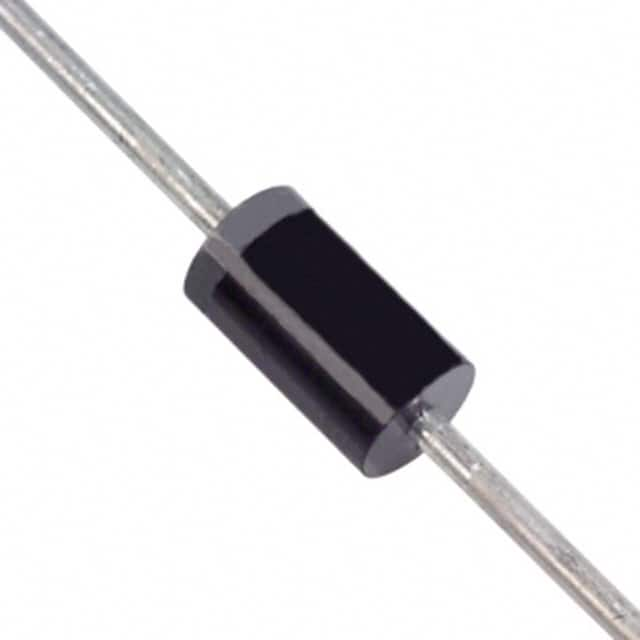1N4752A-T
Product Overview
Category:
The 1N4752A-T belongs to the category of Zener diodes.
Use:
It is commonly used for voltage regulation and voltage reference applications.
Characteristics:
- Zener voltage: 33V
- Power dissipation: 1.0W
- Package type: Axial leaded
- Operating temperature range: -65°C to +200°C
Package:
The 1N4752A-T is typically available in a DO-41 axial package.
Packaging/Quantity:
It is usually supplied in reels or bulk packaging, with quantities varying based on manufacturer specifications.
Specifications
- Zener voltage: 33V
- Power dissipation: 1.0W
- Maximum forward voltage: 1.5V
- Reverse current: 5μA
- Temperature coefficient: 0.05%/°C
Detailed Pin Configuration
The 1N4752A-T has two leads, with the anode connected to the positive terminal and the cathode connected to the negative terminal.
Functional Features
- Precise voltage regulation
- Low reverse leakage current
- High reliability and stability
Advantages
- Accurate voltage regulation
- Wide operating temperature range
- Compact and easy to use
Disadvantages
- Limited power dissipation capability
- Sensitive to temperature variations
Working Principles
The 1N4752A-T operates based on the Zener effect, where it maintains a constant voltage across its terminals when reverse-biased within its breakdown voltage range.
Detailed Application Field Plans
The 1N4752A-T is widely used in various electronic circuits such as voltage regulators, power supplies, and signal conditioning circuits. It is particularly suitable for applications requiring stable voltage references.
Detailed and Complete Alternative Models
Some alternative models to the 1N4752A-T include: - 1N4733A-T (5.1V Zener voltage) - 1N4740A-T (10V Zener voltage) - 1N4764A-T (100V Zener voltage)
In summary, the 1N4752A-T Zener diode is a reliable component for voltage regulation and reference applications, offering precise voltage control and stability within a compact package. Its characteristics and working principles make it suitable for a wide range of electronic circuits, although users should be mindful of its limitations in power dissipation and temperature sensitivity.
[Word count: 332]
Senaraikan 10 soalan dan jawapan biasa yang berkaitan dengan aplikasi 1N4752A-T dalam penyelesaian teknikal
What is the 1N4752A-T diode used for?
- The 1N4752A-T is a Zener diode commonly used for voltage regulation and protection in electronic circuits.
What is the voltage rating of the 1N4752A-T diode?
- The 1N4752A-T has a nominal Zener voltage of 33V, making it suitable for applications requiring stable voltage references.
Can the 1N4752A-T be used for overvoltage protection?
- Yes, the 1N4752A-T can be used to protect sensitive components from overvoltage conditions by shunting excess voltage away from the circuit.
What are the typical applications of the 1N4752A-T diode?
- Typical applications include voltage regulation in power supplies, surge suppression, and voltage reference circuits.
What is the maximum power dissipation of the 1N4752A-T?
- The 1N4752A-T has a maximum power dissipation of 1.3W, allowing it to handle moderate power levels in circuit protection applications.
Is the 1N4752A-T suitable for automotive electronics?
- Yes, the 1N4752A-T can be used in automotive electronics for voltage regulation and transient protection.
What is the temperature coefficient of the 1N4752A-T diode?
- The temperature coefficient is typically around -2mV/°C, ensuring stable performance over a range of operating temperatures.
Can multiple 1N4752A-T diodes be connected in series or parallel?
- Yes, multiple diodes can be connected in series to achieve higher voltage ratings or in parallel to increase current-handling capability.
Does the 1N4752A-T require a heatsink in high-power applications?
- In high-power applications, a heatsink may be necessary to dissipate heat and ensure the diode operates within its temperature limits.
Are there any reliability considerations when using the 1N4752A-T in long-term applications?
- The 1N4752A-T has a solid-state design, offering good reliability for long-term use, but proper derating and thermal management should be considered for extended operation.


